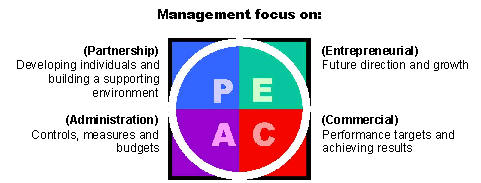| How to
sustain employee productivity & meet shareholder expectations
The challenge
facing both private and public sector organisations in the future will be
how to sustain employee productivity while meeting increasing shareholder
expectations.
This insight is the result
of extensive research conducted by The Ryder Self Group during 1999 to 2002
with over 10,000 employees from both public and private sector organisations.
The sample profile appears below.
Private sector
organisations are faced with greater demands for achieving profit and
compounding growth targets. There is greater pressure on public sector
organisations for accountability of public funds. Yet, employees believe
management’s lack of investment in the organisation, its systems, equipment
and people will make it extremely difficult to sustain productivity
increases in the future.
The
findings of the research are based on The Ryder Self Group’s PACE© culture
model which measures four key organisational cultures illustrated below.
The model displays what managers predominantly focus on in each of the four
different cultures.

Across the organisations surveyed, we found that employees described
their current culture as the PACE© Administration culture. This means that
all these organisations had a very strong focus on controls, measures and
budgets for the purpose of establishing internal efficiencies and reducing
operating costs to meet shareholder requirements.
Comparing the current culture with employees’ preferred culture
and the organisation’s ideal culture (how customers would prefer to
be serviced), we have been able to demonstrate clearly that most
organisations’ current and ideal culture profiles seem to be aligned while
being misaligned with employees’ preferred culture.
The table below shows
the aggregate Culture Index for all of the organisations, clearly displaying
the difference between the current, preferred and ideal cultures (in red).
|
Culture |
Current
% |
Preferred
% |
Ideal
% |
|
Partnership |
17.6 |
41.7 |
21.7 |
|
Administration |
30.2 |
9.2 |
37.8 |
|
Commercial |
26.7 |
22.9 |
30.3 |
|
Entrepreneurial |
25.5 |
26.3 |
10.2 |
The organisations’ current and ideal cultures
are dominated by the PACE© Administration culture, while employees prefer a
more supportive culture where managers focus on developing individuals
(Partnership).
Why do employees show a
resistance to the Administration Culture? We analysed employee comments to
delve deeper into why this difference occurred.
Employees reported that their high level of resistance to the Administration
culture is due to its inability to truly deliver internal efficiencies:
-
Additional reporting
requirements and controls have only added to employee workload.
-
Costs have been mostly
cut by not replacing staff, not updating old equipment, employing
temporary or contract staff instead of permanent employees.
Consequently, employee morale and quality of life have deteriorated with
employees having to work at reduced levels of productivity and longer hours
to cope with increased workload and inefficient, old equipment.
Furthermore, employment of contract or temporary staff results in friction
with salaried staff. The reduced numbers of salaried staff feel they carry
the burden or responsibility while contract staff earn higher rates with
reduced responsibilities.
-
High use of temporary staff also puts additional strain on permanent
employees due to continuous training of temporary staff.
-
Employees are concerned with remuneration and incentives because of the
high level of unpaid overtime and their worth relative to management and
contract staff in terms of incentives and remuneration paid.
Employees would prefer an efficient culture where systems, equipment and
procedures improve their productivity and make it easier and quicker to
service customers. Instead, what they have been experiencing is the ‘dark
side’ of the Administration culture.
It would appear to the shareholders that these organisations delivered
higher levels of financial performance and accountability through a
culture focused on budgets, controls and cost containment.
In reality,
employees’ hard work and sacrifice have mostly delivered the increased
financial performance which can only last so long. At some point,
organisations will need to make the long-term investment in systems,
equipment, processes and its people to ensure that employee productivity
is increased in a more sustainable manner.
Our findings are based on research conducted between 1999 and 2002 with over
10,000 employees across the following organisations:
|
Organisation Type |
|
Industrial Business-to-Business Service & Product Provider |
|
Commercial Business to-Business service & product providers (3) |
|
Education Service Provider |
|
Internal IT service provider |
|
Internal Shared Service Providers (2) |
|
Public Service Providers (3) |
š Next
© The Ryder Self Group 2003 |